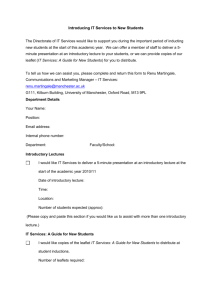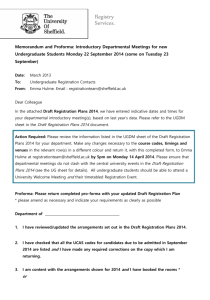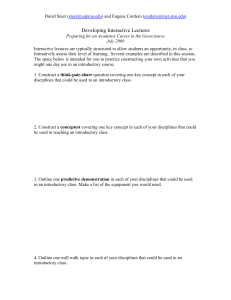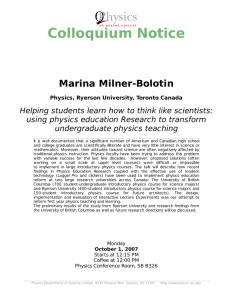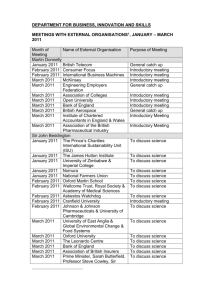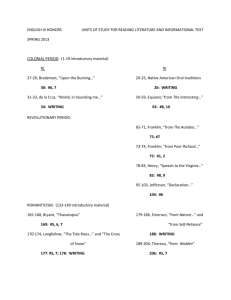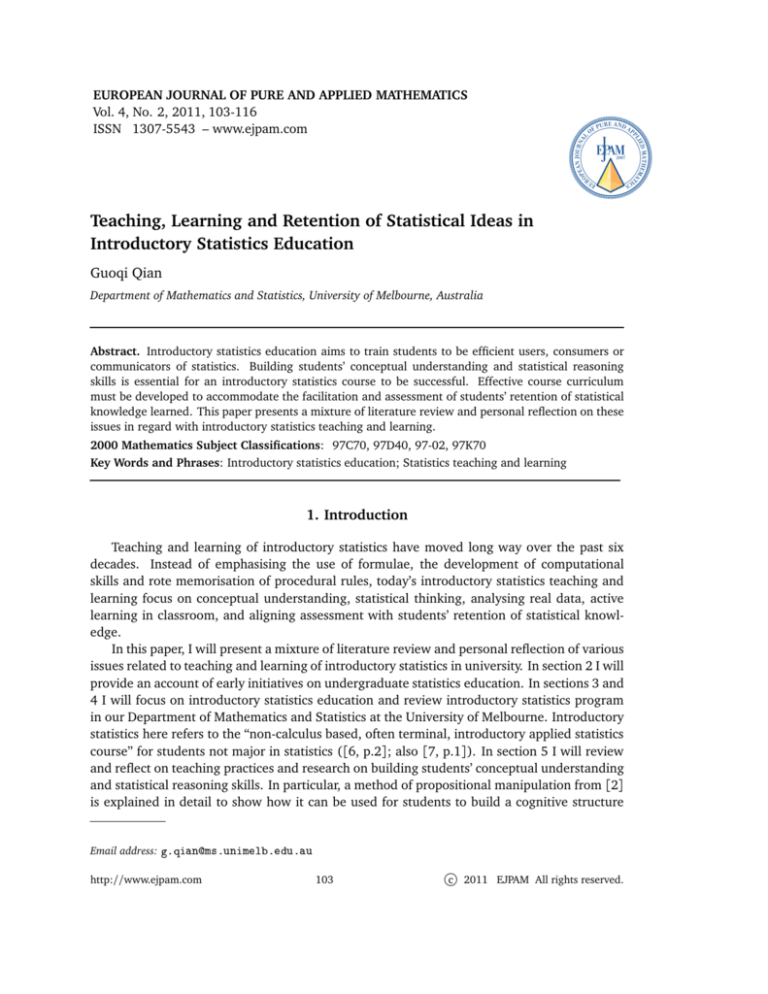
EUROPEAN JOURNAL OF PURE AND APPLIED MATHEMATICS
Vol. 4, No. 2, 2011, 103-116
ISSN 1307-5543 – www.ejpam.com
Teaching, Learning and Retention of Statistical Ideas in
Introductory Statistics Education
Guoqi Qian
Department of Mathematics and Statistics, University of Melbourne, Australia
Abstract. Introductory statistics education aims to train students to be efficient users, consumers or
communicators of statistics. Building students’ conceptual understanding and statistical reasoning
skills is essential for an introductory statistics course to be successful. Effective course curriculum
must be developed to accommodate the facilitation and assessment of students’ retention of statistical
knowledge learned. This paper presents a mixture of literature review and personal reflection on these
issues in regard with introductory statistics teaching and learning.
2000 Mathematics Subject Classifications: 97C70, 97D40, 97-02, 97K70
Key Words and Phrases: Introductory statistics education; Statistics teaching and learning
1. Introduction
Teaching and learning of introductory statistics have moved long way over the past six
decades. Instead of emphasising the use of formulae, the development of computational
skills and rote memorisation of procedural rules, today’s introductory statistics teaching and
learning focus on conceptual understanding, statistical thinking, analysing real data, active
learning in classroom, and aligning assessment with students’ retention of statistical knowledge.
In this paper, I will present a mixture of literature review and personal reflection of various
issues related to teaching and learning of introductory statistics in university. In section 2 I will
provide an account of early initiatives on undergraduate statistics education. In sections 3 and
4 I will focus on introductory statistics education and review introductory statistics program
in our Department of Mathematics and Statistics at the University of Melbourne. Introductory
statistics here refers to the “non-calculus based, often terminal, introductory applied statistics
course” for students not major in statistics ([6, p.2]; also [7, p.1]). In section 5 I will review
and reflect on teaching practices and research on building students’ conceptual understanding
and statistical reasoning skills. In particular, a method of propositional manipulation from [2]
is explained in detail to show how it can be used for students to build a cognitive structure
Email address: g.qianms.unimelb.edu.au
http://www.ejpam.com
103
c 2011 EJPAM All rights reserved.
G. Qian / Eur. J. Pure Appl. Math, 4 (2011), 103-116
104
representing understanding of statistical propositions and their inter-relationships. Finally, in
section 6 I will review and reflect the current activities on how to facilitate and assess students’
retention of statistical knowledge obtained from introductory statistics education.
2. Connection and Difference Between Statistics Research or Applications and
Statistics Education
Probably there are still debates on whether statistics is an independent discipline or a
branch of mathematics. But the fact that the use of statistics and statistical methods is so
widespread in so many areas including business, research and daily life has informed us the
necessity of establishing a well-grounded undergraduate statistics education program in universities, from which students can be trained to be effective users, consumers or communicators of statistical knowledge.
Developing an undergraduate statistics education program requires selection of appropriate statistical knowledge and material to build a coherent curriculum and creation of an
effective teaching and learning environment to deliver the curriculum. This is different from
developing new statistical methods or performing statistical applications in practice. The latter is more related to and often the focus of postgraduate statistical research programs.
Samuel Wilks was the 45th president of the American Statistical Association (ASA). In his
1950 ASA presidential address [14, republished] he regarded it a big challenge before the statistical community to develop an adequate program of undergraduate statistics education. He
noticed at the time that while undergraduate calculus-based mathematics education program
for servicing science and engineering disciplines were well established in USA universities,
efforts of statistics education were mostly focused on post-graduate programs because most
statistical methods were developed using advanced mathematical approaches and statisticians
were perceived as those holding advanced degrees. Nevertheless, Wilks believed it was imperative and possible to develop an undergraduate statistics education program without resorting
to advanced mathematical knowledge and techniques. Wilks’ proposed solution was:
a. Developing a sequence of two full-year courses which will consist of concepts and skills
mainly from probability, statistics, logic and experimental philosophy, together with
some prerequisite mathematics;
b. Placing these courses in the first and second years;
c. Requiring students expecting to go into the social and biological sciences and business
to take these courses.
Wilks’ proposal is based on the assumption that students in these fields need basic training
in scientific methodology analogous to that received by engineering and physical science students in mathematics through calculus.
More than six decades have passed since Wilks’ address, during which we have seen the
focus of statistics education around the world including Australia gradually shifts in a topdown direction to undergraduate programs. On the other hand, Wilks’ proposal has also been
G. Qian / Eur. J. Pure Appl. Math, 4 (2011), 103-116
105
gradually reformed by many statistical educators to reflect the evolution of statistics and the
changes of people who apply statistics. In particular, we have seen the establishment of different undergraduate statistics education programs: some are for students majoring in statistics
and mathematics which are often calculus and probability based; some are for students majoring in other disciplines which are often non-calculus and application oriented. Also the
undergraduate statistics education programs are nowadays delivered by not only statisticians
but also professionals from other disciplines such as agriculture, biology, business, economics,
engineering and psychology etc.. The pros and cons of teaching undergraduate statistics by a
particular profession or department are very much under debate, especially true in Australia,
which concerns educational, administrative and funding issues. From an educational point
of view, it should be a consensus that undergraduate statistics must be taught by qualified
statisticians in order to ensure the quality of statistical teaching and learning.
The most influential reform on undergraduate statistics education is the one initiated by
ASA since 1998 when Robert Hogg and James Higgins addressed the plight of undergraduate
statistics education to the American Statistician session at the 1998 Joint Statistical Meetings
[see 8] . This resulted in the launching of the Undergraduate Statistics Education Initiative
(USEI) group in 1999 and publication of Curriculum Guidelines for Undergraduate Programs
in Statistical Science (CGUPSS)∗ . According to ASA’s curriculum guidelines, “Undergraduate
statistics programs should emphasize concepts and tools for working with data and provide
experience in designing data collection and in analyzing real data that go beyond the content
of a first course in statistics methods” . The ASA’s curriculum guidelines should also be applied
to Australian undergraduate statistics education.
3. Introductory Statistics Education
Among different undergraduate statistics education programs we now focus on introductory statistics education. As mentioned in section 1, introductory statistics refers to the “noncalculus based, often terminal, introductory applied statistics course” for students not majoring in statistics. Introductory statistics courses are also called service statistics courses in
Australian universities.
Numerous research and reforms on improving teaching and learning of introductory statistics have been seen in recent years. A milestone on this development is ASA’s Guidelines for
Assessment and Instruction in Statistics Education (GAISE) College Report [5], which sets
forth six recommendations for teaching and learning introductory statistics: emphasise statistical literacy and develop statistical thinking, use real data, stress conceptual understanding
rather than mere knowledge of procedures, foster active learning in the classroom, use technology for developing conceptual understanding and analysing data, and use assessments to
improve and evaluate student learning [c.f. 7, p.1]. These GAISE recommendations are interconnected, and should be mastered and implemented in an integral way in any introductory
statistics education program. It should be noted that these recommendations are not exclusive only to introductory statistics education. For example, the ideas of scientific reasoning,
∗
http://www.amstat.org/eduation/urriulumguidelines.fm; also see [3]
G. Qian / Eur. J. Pure Appl. Math, 4 (2011), 103-116
106
active learning, conceptual understanding, use of technology, and appropriate assessments
are related to and in general supported by the Nine Principles Guiding Teaching and Learning
at the University of Melbourne [4]. The nine principles are:
1. An atmosphere of intellectual excitement
2. An intensive research and knowledge transfer culture permeating all teaching and learning activities
3. A vibrant and embracing social context
4. An international and culturally diverse learning environment
5. Explicit concern and support for individual development
6. Clear academic expectations and standards
7. Learning cycles of experimentation, feedback and assessment
8. Premium quality learning spaces, resources and technologies
9. An adaptive curriculum
A literature review of recent research on introductory statistics education is the one written
by Zieffler et al [15]. The reviews focuses on the following areas:
1. Studies on the nature and cause of faulty statistical reasoning
• studies that explore the nature of faulty reasoning
• studies that explore why students have faulty reasoning
• what these studies have to offer teachers of statistics
• questions and considerations raised by the studies in this area
2. Studies on students’ statistical reasoning
• quantitative approaches to assessing statistical reasoning
• qualitative approaches to assessing statistical reasoning
• what these studies have to offer teachers of statistics
• questions and considerations raised by the studies in this area
3. Studies of non-cognitive outcomes and factors that affect the learning of statistics at the
college level
• instruments to assess non-cognitive factors related to college students’ learning
statistics
• studies on the role of non-cognitive factors (e.g. students’ affect and attitudes)
• qualitative studies on non-cognitive factors
G. Qian / Eur. J. Pure Appl. Math, 4 (2011), 103-116
107
• what these studies have to offer teachers of statistics
• questions and considerations raised by the studies in this area
4. Research studies focused on teaching statistics to college students
• studies focused on student learning
• studies focused on pedagogical methods
• studies focused on developing a particular concept or type of statistical reasoning
• what these studies have to offer teachers of statistics
• questions and considerations raised by the studies in this area
The review provides the following findings and implications for university statistics teachers
[15, p.14]:
Many of the studies have shown that statistics remains a pervasively difficult subject for students. Several of the concepts that college students encounter in an
introductory course (e.g., sampling distributions, power) have been extensively
studied with disheartening results. Students have shown inconsistencies in their
reasoning about the most “elementary” concepts of measures of central tendency
and spread. Research has also shown that many college students enter introductory statistics courses with a fair amount of trepidation and anxiety, and that these
feelings tend to persist throughout the course.
While these findings seem apocalyptic for students’ opportunities to learn statistics, there is much that teachers can learn from these results. For starters, teachers
should not overestimate the degree to which they believe students have learned
or understand even the most basic concepts in an introductory statistics course.
Teachers looking to find out what their students actually know can benefit from
the use of “good” assessment items.
Another suggestion for teachers is to examine students’ response pattern across assessment items to help identify inconsistencies in their statistical reasoning. While
changing student affect seems to be a daunting task for any teacher of statistics,
there is evidence to suggest that the anxiety students feel toward statistics may be
related to mathematics anxiety and that this may be reduced by de-emphasizing
the mathematics that occurs in a more “traditional” course. Likewise, educational
research shows that some test anxieties can be decreased by using more nontraditional types of assessments such as student projects or portfolios.
Finally, statistics teachers at the college level could benefit from reading the literature on the teaching and learning of statistics. Often, the research not only points
out pitfalls for students in learning statistics, but also offers insight into possible
remedies via technology or teaching points. The research literature can provide a
blueprint for designing or improving curriculum.
G. Qian / Eur. J. Pure Appl. Math, 4 (2011), 103-116
108
4. Introductory Statistics in University of Melbourne
Currently, five courses at the introductory statistics level are offered by the Department of
Mathematics and Statistics at the University of Melbourne. These are 800-101 Critical Thinking with Data, 620-159 Data Analysis 1, 620-168 Experimental Design and Data Analysis,
620-272 Statistics for Optometrists, and 620-370 Statistics for Mechanical Engineers. Among
them, 800-101 is a university breadth subject which can be taken by any first-year undergraduate students in the university; 620-159 is available to any students with scores of VCE
(Victorian Certificate of Education) Mathematical Methods 3/4 subject being at least 25 or
with equivalent mathematics skills, and 620-159 is usually taken by students from science,
engineering and commerce; 620-168 is for students enrolled in Bachelor of Biomedicine only;
620-272 is for students enrolled in Bachelor of Optometry only; and 620-370 is for students
enrolled in Bachelor of Mechanical Engineering only.
From a brief investigation of the curricula of these five courses one can conclude that
they conform to those guidelines of CGUPSS, GAISE and the University of Melbourne’s nine
principles that are mentioned in sections 2 and 3. One should also be aware that these courses
are subject to change and improvement in the future. And it is the department and its staff’s
responsibility to create effective teaching and learning environments for students so that they
can be equipped with good statistical minds from these courses.
As I am the course coordinator for 620-159 it is possible for me to present more information on this course.
620-159 Data Analysis 1 Course Description: This subject lays the foundations
for an understanding of the fundamental concepts and reasoning of probability
and statistics required for data analysis. Students should develop expertise in
some of the statistical techniques commonly used in the design and analysis of
experiments, and will gain experience in the use of major statistical computing
package. They should develop skills in collecting random samples, data description, basic statistical inference including parametric and nonparametric tests to
compare population proportions and means, data manipulation and statistical
computing. The methods will be illustrated using applications from science, engineering and commerce. Descriptive statistics, data manipulation and the implementation of the statistical procedures covered in lectures will be reinforced in
the computer laboratory classes.
Syllabus: Sampling; introduction to experimental design; review of simple probability; estimation; confidence intervals; hypothesis testing including types of errors and power; inferences about means and proportions based on single and independent samples; matched pairs designs; introduction to nonparametric methods; contingency tables; regression; and analysis of variance.
Assessment: Up to 25 pages of written assignments 10% (during semester); two
45-minute computer laboratory tests 10% (held during semester); a 3-hour written examination 80% (held in the examination period).
G. Qian / Eur. J. Pure Appl. Math, 4 (2011), 103-116
109
In the next two sections I will address several issues of teaching and learning in introductory statistics education where I use 620-159 for illustration when appropriate.
5. Build Conceptual Understanding in Teaching and Learning of Introductory
Statistics
As what is shown in [15] undergraduate students often find statistics, especially introductory statistics courses difficult. In the course 620-159 and the similar courses offered by
our department, many students find statistics difficult or confusing or boring or scaring, even
though many of them can complete the courses with pretty good results. This may be partly
related to the non-cognitive factors such as students’ affect and attitudes toward statistics.
The paper “Truth, Damn Truth and Statistics” by Velleman [13] is a very powerful one to push
back against the popular negative impression, caused by these factors, that statistics teaches
how to lie with data. However, the difficulty experienced by students’ learning introductory
statistics may be largely attributed to the following teaching and learning factors.
First, theories and mathematical derivations underlying many commonly and easily used
statistical methods taught in the course are too many, often cumulative and too abstract to students at the first-year level. For example, variance is commonly used to measure the variability
of data. But the theory behind the variance involves probability, random variable and probability distribution; and entails that different types of variance are used in different situations.
Sometimes one must use the sample variance, while at other times must use the population
variance. Sometimes the variance must be estimated, and how it is estimated must depend
on the model under consideration. Without learning the theory of variance it would be very
challenging for students to decide which correct variance method should be used in each situation. As another example, normal distribution and central limit theorem are fundamental for
almost every hypothesis testing or confidence interval problem in an introductory course, yet
one can hardly find any introductory statistics book that gives sufficient mathematical treatment of these two topics. It would be essentially meaningless and does not help of students’
Rx
− 1 (t−µ)2
d t is
understanding at all to simply present to students that F(x; µ, σ) = −∞ σp12π e 2σ2
the normal probability distribution function and that most summary statistics can have their
probability distribution functions be approximated by F(x; µ, σ) in the limit. The dilemma is
that the students’ mathematics skills are not up to the level required for understanding the
normal distribution theory but they still need to use normal probability.
Second, students often perceive statistics as procedural and computational, but fail to
integrate them with the underlying ideas and logic. One such example is about learning correlation coefficient between two quantitative variables. Most students have no difficulty in
computing the correlation for given observations of two quantitative variables once they are
provided with the formula. But some students fail to understand that it is not appropriate to
describe the association between two categorical variables or between a quantitative and a
categorical variable by correlation coefficient. E.g., it is not correct to say that the correlation
coefficient between people’s height and gender is 0.7, even though people’s height and gender have an association. Moreover, some students fail to see that the correlation coefficient
G. Qian / Eur. J. Pure Appl. Math, 4 (2011), 103-116
110
between x and y equals zero does not mean x and y have no relationship; it only means x
and y have no linear relationship. Further, some students fail to realise that, due to chance
involved in the data collection process, the sample correlation coefficient between observations of x and y may still not equal zero even though the (population) correlation coefficient
between x and y equals zero.
Third, there is not enough teaching and learning resources to help students learn introductory statistics. To cope with the budget and funding constraints, lecture class size is made
larger today than before (subject 620-159 has 170 students); and access to tutors’ help is
available only during the two-hour tutorial and computer laboratory class per week for 620159 students. On the other hand, students want to have more teaching contact time as their
current mathematical and statistical self-learning skills are not good enough.
Knowing the aforementioned factors that negatively affect students’ learning success in
introductory statistics courses, there have been surged teaching and research activities in
recent years aiming at improving the effectiveness and efficiency of learning introductory
statistics. It has been realised by more and more people that building statistical conceptual
understanding and reasoning is a key for the success of learning and teaching introductory
statistics.
The paper “Teaching statistical concepts, fundamentals and modelling” by Timothy O’Brien
[10] considers some issues in designing an introductory course focusing on statistical concepts
rather than memorising formulae, and shows how to successfully teach statistical concepts.
The paper “Reasoning and communicating in the language of statistics” by Carol Parke
[11] argues that, to succeed in their future careers, students must be provided with opportunities to develop deep understanding of concepts, develop reasoning skills, and become familiar
with verbalising and writing about statistics. The paper describes an instructional approach
that spans the entire semester of a statistics course and consists of several aspects including
cognitively rich individual assignments, small group activities, and a student-led scoring activity. To demonstrate the impact of this approach on student learning, the author collected
qualitative and quantitative data from students in two introductory statistics courses. Several
assessments indicated improvement in students’ reasoning and understanding, written and
verbal communication, and confidence.
Use of modern techniques in introductory statistics education may help to facilitate students’ conceptual understanding, and make the subject more interesting and relevant to a
wider variety of students. For example, the lecture lectopia technology has been used in 620159 due to the demand of some students who have a few timetable clashes and some other
students who want to recap the lectures. However, it has been found that, while about 50% of
the students accessed the recordings in the first three weeks of the semester, the recording accessing rate was mostly about 10% during the rest of the semester. This finding reinforces the
claim that the key for successful learning and teaching of introductory statistics is conceptual
understanding and reasoning.
In order for students to build a cognitive structure representing an understanding of
statistics in terms of links and relationships between the important concepts, Nick Broers
[2] proposed a didactic method that stimulates students to self-explain the study material.
The method, named the method of propositional manipulation (MPM), consists of two major
G. Qian / Eur. J. Pure Appl. Math, 4 (2011), 103-116
111
steps: structuring study material into knowledge fragments and manipulating propositions. In
the first step, the lecturer decides and informs students which particular links and relationships between concepts that they should explore. In the second step, students are asked to
self-explain the study material using the propositions constructed from the related concepts
and their relationships. For a particular topic or statement, students are asked to identify
the propositions that underlie the statistical theory. They are then asked to manipulate these
propositions by constructing arguments showing a given statement to be either true or false.
The MPM method is executed each time after the lecturer introduces a particular topic by
explaining the relevant concepts and methods and illustrating elaborated examples. To see
how the MPM method works, I implemented it in the 620-159 course after I introduced the
topics of confidence interval and hypothesis testing for population mean. I gave students a
list of 35 questions (which are modified from [2], listed on the course LMS (Learning Management System, an online database storing teaching material) and shown below) prompting
them to explore the propositions learned in related to confidence interval and hypothesis testing. A ten-page dictionary-style booklet of statistics terms introduced in 620-159 (available on
the course LMS) was also given to students. To illustrate how to do MPM step 2, I constructed
arguments from these propositions to show why the following two statements are true:
1. The smaller the p-value is, the stronger is the evidence in favour of the alternative
hypothesis.
2. If a 95% confidence interval for a population mean µ is (4.2, 4.8), then the p-value for
testing the research hypothesis that the population mean does not equal 5 is less than
5%.
The students were then asked to do MPM step 2 themselves in their tutorial and assignment
work by following the 35 questions supplied. Several students told me that they really liked
this approach immediately after the lecture.
The 35 questions used in MPM to help understand hypothesis testing and confidence
intervals (modified from [2]):
1. What do we mean by the null hypothesis?
2. What do we mean by the alternative hypothesis?
3. When would we choose for a one-sided alternative, and when would we choose for a
two-sided alternative?
4. What is a test statistic?
5. What is meant by the sampling distribution of the test statistic?
6. Why is this sampling distribution a conditional probability distribution?
7. Which test statistic would we use when testing a hypothesis on the population mean
(assuming the population variance to be known/unknown)?
G. Qian / Eur. J. Pure Appl. Math, 4 (2011), 103-116
112
8. Can we say anything about the shape of the sampling distribution of this test statistic?
9. What is meant by the p-value of the test statistic?
10. Why is this p-value a conditional probability?
11. What is meant by the significance level?
12. What do we mean by the statement “The result is significant at the 5% level” ?
13. In the context of testing a hypothesis, what is meant by the critical region or the critical
value of the sampling distribution of the test statistic?
14. Why is a significant result not necessarily an important or even meaningful result?
15. Which five steps are common to all tests of significance?
16. What is meant by the power of the significance test?
17. Suppose we wish to test H0 : µ = µ0 against H1 : µ > µ0 . Assuming a specific alternative
value µa , how could we calculate the power of this test?
18. By what three ways can you increase the power of the test?
19. What is meant by a Type I error?
20. What is meant by a Type II error?
21. How do you determine the probability of a Type I error?
22. Is there a way of determining the probability of a Type II error?
23. How is the probability of a Type II error related to the power of the test?
24. For a hypothesis test on a population mean, how could you graphically display the
probability of a Type I and a Type II error?
25. For a hypothesis test on a population mean, how could you graphically display the
power of the test?
26. What is meant by a point estimate of the population mean?
27. How should we interpret a 95% confidence interval for the population mean (i.e. what
does it actually mean to say that “we are 95% confident” )?
28. What does a 95% confidence interval for the population mean have to do with the
sampling distribution for the sample mean?
29. What two key assumptions should be met in order for the 95% confidence interval to
yield valid information on the population mean?
G. Qian / Eur. J. Pure Appl. Math, 4 (2011), 103-116
113
30. What is meant by the margin of error?
31. What three factors determine the margin of error?
32. How do you calculate a 95% confidence interval for the population mean?
33. How can a high level of confidence go together with a small margin of error?
34. What is the relationship among confidence level, margin of error and sample size?
35. What is the relationship between a 95% confidence interval and a two-sided hypothesis
test with 5% significance level?
6. Develop an Appropriate Course Curriculum to Facilitate Students’ Retention
of Statistical Knowledge
A fundamental objective of introductory statistics education is to train our students to be
good users, consumers or communicators of statistical knowledge, depending on the extents
to which the students’ future careers are related to statistics. A necessary requirement for this
objective to be realised is that the students are able to understand and retain an appropriate
set of statistical knowledge they have learned.
While the importance of achieving conceptual understanding and reasoning is widely studied in statistical education sector as is discussed in previous sections, the issue of students’
retention of statistical knowledge has not been directly studied until recently. One of the first
such studies may be found in [1] which is based on a panel presentation sponsored by the
Section on Statistical Education at the 2006 American Joint Statistical Meetings in Seattle.
This paper presents a number of perspectives on the issue of students’ retention of essential
statistical concepts, ideas, and topics and the assessments thereof.
The questions of our interest are:
1. What aspects of statistical knowledge should students retain?
2. How do we facilitate retention in statistics classes?
3. Is it possible to assess students’ retention of statistical knowledge? And how?
Berenson et al [1] has argued that what to be retained should be aligned with the objective
of training students to be effective users, consumers and communicators of statistics. Based
on this argument, essential statistical ideas and concepts should be retained; and in order
for this to happen, formal procedures, derivations and lengthy computations etc. should be
taught and learned only when these help to the retention. The alignment principle is adopted
in 620-159 teaching and learning. For example, sampling distribution is an essential concept
for statistical inference. Therefore the associated computer simulation based derivations and
formal formulation procedure conforming to students’ skills base are demonstrated to students, because they help students understand the sampling distribution concept and build it
into their skills bases.
REFERENCES
114
Students must be engaged in the learning process in order to facilitate the retention. Peter Howley from the University of Newcastle developed, based on his introductory statistics
teaching experience, an approach of three components to engage, enthuse and educate students in the statistical learning process. The approach can be described by three phrases:
keeping it real, keeping them interested and keeping it in their minds [9, c.f.]. It involves initially assisting students to recognise the benefits of learning the course content and to reduce
their previously-held misperceptions and fears of statistics. It then uses diagrams and series
of questions to enable students to successfully explain or define a concept themselves in lieu
of being told, which engages students and removes the mystery and foreignness that would
otherwise accompany the learning of such concepts. It further uses a number of cognitive
techniques such as memory jogs to support students’ learning experiences and abilities to
recall information.
Roseth et al [12] provides practical examples of how introductory statistics educators may
apply a cooperative framework to classroom teaching and teachers collaboration, in a hope to
persuade those statistics educators who are reluctant to engage students in their learning to
adopt more student-centred active teaching strategies.
In comparison with the assessment practices focusing on evaluation of ongoing progress
of learning during a course, it may be difficult to see how to develop assessment practices
that refer to the retention of statistical knowledge at a later period in time. Berenson et al
[1] suggests that opportunities to assess retention of learning must be seized. In my understanding, the opportunities are those that can project students’ abilities of applying statistics
in practice. Therefore, the retention assessment practice can include in-class quick quizzes
which are mostly made of multiple choice questions; executive summary report writing which
is appropriate for experimental design and exploratory data analysis tasks; computer laboratory tests which assess hands-on data analysis skills; assignments; and final examination etc..
All of these practices are adopted in 620-159 Data Analysis 1 teaching and learning.
7. Summary
From statistical research development and statistical applications we have realised the
necessity and importance of establishing a well-grounded introductory statistical education
program for undergraduate students. Using literature review and local teaching experience
we conclude that a key for successful learning and teaching of introductory statistics is building students’ skills on conceptual understanding and statistical reasoning. We also review and
reflect on the current research and practice of introductory statistics education in regard to
why it is important and how to facilitate and assess students’ retention of statistical knowledge.
References
[1] Berenson, M.L. Utts, J., Kinard, K.A., Rumsey, D.J., Jones, A. and Gaines, L.M. Assessing
student retention of essential statistical ideas: perspectives, priorities, and possibilities.
The American Statistician, 62(1):54–61, 2008.
REFERENCES
115
[2] Broers, Nick J. Helping students to build a conceptual understanding of elementary
statistics. The American Statistician, 62(2):161–166, 2008.
[3] Bryce, G.R.
Undergraduate statistics education:
an introduction and review of selected literature.
Journal of Statistics Education, 10(2), http://
www.amstat.org/publications/jse/v10n2/bryce.html, 2002.
[4] Centre for the Study of Higher Education of the University of Melbourne.
Nine Principles Guiding Teaching and Learning.
University of Melbourne,
http://www.learningandteaching.unimelb.edu.au/__data/assets/pdf_file/0012/
276996/ 9principles.pdf, 2007.
[5] GAISE College Report writing team.
Guidelines for assessment and instruction in statistics education college report.
American Statistical Association.,
http://www.amstat.org/education/gaise/index.cfm, 2005.
[6] Garfield, J.B. Evaluating the impact of educational reform in statistics: A survey of introductory statistics courses. Final Report for NSF REC Grant #9732404,
http://education.umn.edu/EdPsych/Projects/Impact.html, 2000.
[7] Hall, Megan R. and Rowell, Ginger Holmes.
Introductory statistics education and national science foundation.
Journal of Statistics Education, 16(2),
http://www.amstat.org/publications/jse/v16n2/rowell.html, 2008.
[8] Higgins, James J. Nonmathematical statistics: a new direction for the undergraduate
discipline. The American Statistician, 53(1):1–6, 1999.
[9] Howley,
Peter P.
Keeping it real,
keeping them interested and
keeping it in their minds.
Journal of Statistics Education, 16(1),
http://www.amstat.org/publications/jse/v16n1/howley.html, 2008.
[10] O’Brien, Timothy E. Teaching statistical concepts, fundamentals and modelling. Teaching
Statistics., 30(3):81–85, 2008.
[11] Parke,
Carol
S.
Reasoning
and
communicating
in
the
language
of
statistics.
Journal
of
Statistics
Education,
16(1),
http://www.amstat.org/publications/jse/v16n1/parke.html, 2008.
[12] Roseth, C.J., Garfield, J.B. and Ben-zvi, D.
Collaboration in learning and teaching statistics.
Journal of Statistics Education, 16(1),
http://www.amstat.org/publications/jse/v16n1/roseth.html, 2008.
[13] Velleman, Paul F. Truth, damn truth, and statistics. Journal of Statistics Education, 16(2),
http://www.amstat.org/publications/jse/v16n2/velleman.html, 2008.
[14] Wilks, S.S. Undergraduate statistical education. The American Statistician, 60(1):39–45,
also available at www.asapresidentialpapers.info, 2006.
REFERENCES
116
[15] Zieffler, A., Garfield, J., Alt, S., Dupuis, D., Holleque, K. and Chang, B. What
does research suggest about the teaching and learning of introductory statistics at
the college level? a review of the literature. Journal of Statistics Education, 16(2),
http://www.amstat.org/publications/jse/v16n2/zieffler.html, 2008.

